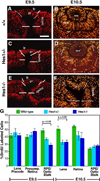Multiple requirements for Hes 1 during early eye formation
- PMID: 16038893
- PMCID: PMC4128414
- DOI: 10.1016/j.ydbio.2005.06.010
Multiple requirements for Hes 1 during early eye formation
Abstract
During embryogenesis, multiple developmental processes are integrated through their precise temporal regulation. Hes1 is a transcriptional repressor that regulates the timing of mammalian retinal neurogenesis. However, roles for Hes1 in early eye development have not been well defined. Here, we show that Hes1 is expressed in the forming lens, optic vesicle, cup, and pigmented epithelium and is necessary for proper growth, morphogenesis, and differentiation of these tissues. Because Hes1 is required throughout the eye, we investigated its interaction with Pax6. Hes1-Pax6 double mutant embryos are eyeless suggesting these genes are coordinately required for initial morphogenesis and outgrowth of the optic vesicle. In Hes1 mutants, Math5 expression is precocious along with retinal ganglion cell, amacrine, and horizontal neuron formation. In contrast to apparent cooperativity between Pax6 and Hes1 during morphogenesis, each gene regulates Math5 and RGC genesis independently. Together, these studies demonstrate that Hes1, like Pax6, simultaneously regulates multiple developmental processes during optic development.
Figures







Similar articles
-
Precocious retinal neurons: Pax6 controls timing of differentiation and determination of cell type.Dev Biol. 2005 Mar 15;279(2):308-21. doi: 10.1016/j.ydbio.2004.12.018. Dev Biol. 2005. PMID: 15733660 Free PMC article.
-
Math5 encodes a murine basic helix-loop-helix transcription factor expressed during early stages of retinal neurogenesis.Development. 1998 Dec;125(23):4821-33. doi: 10.1242/dev.125.23.4821. Development. 1998. PMID: 9806930
-
Different roles for Pax6 in the optic vesicle and facial epithelium mediate early morphogenesis of the murine eye.Development. 2000 Mar;127(5):945-56. doi: 10.1242/dev.127.5.945. Development. 2000. PMID: 10662634
-
Pax6: a multi-level regulator of ocular development.Prog Retin Eye Res. 2012 Sep;31(5):351-76. doi: 10.1016/j.preteyeres.2012.04.002. Epub 2012 May 3. Prog Retin Eye Res. 2012. PMID: 22561546 Review.
-
Regulation of gene expression by Pax6 in ocular cells: a case of tissue-preferred expression of crystallins in lens.Int J Dev Biol. 2004;48(8-9):829-44. doi: 10.1387/ijdb.041866ac. Int J Dev Biol. 2004. PMID: 15558475 Free PMC article. Review.
Cited by
-
Building the developmental oculome: systems biology in vertebrate eye development and disease.Wiley Interdiscip Rev Syst Biol Med. 2010 May-Jun;2(3):305-323. doi: 10.1002/wsbm.59. Wiley Interdiscip Rev Syst Biol Med. 2010. PMID: 20836031 Free PMC article. Review.
-
Cell fate decisions, transcription factors and signaling during early retinal development.Prog Retin Eye Res. 2022 Nov;91:101093. doi: 10.1016/j.preteyeres.2022.101093. Epub 2022 Jul 8. Prog Retin Eye Res. 2022. PMID: 35817658 Free PMC article. Review.
-
Lens differentiation is controlled by the balance between PDGF and FGF signaling.PLoS Biol. 2019 Feb 4;17(2):e3000133. doi: 10.1371/journal.pbio.3000133. eCollection 2019 Feb. PLoS Biol. 2019. PMID: 30716082 Free PMC article.
-
Suppressor of fused is required to maintain the multipotency of neural progenitor cells in the retina.J Neurosci. 2011 Mar 30;31(13):5169-80. doi: 10.1523/JNEUROSCI.5495-10.2011. J Neurosci. 2011. PMID: 21451052 Free PMC article.
-
Multiple roles for Pax2 in the embryonic mouse eye.Dev Biol. 2021 Apr;472:18-29. doi: 10.1016/j.ydbio.2020.12.020. Epub 2021 Jan 9. Dev Biol. 2021. PMID: 33428890 Free PMC article.
References
-
- Ahmad I, Dooley CM, Polk DL. Delta-1 is a regulator of neurogenesis in the vertebrate retina. Dev. Biol. 1997;185:92–103. - PubMed
-
- Akagi T, Inoue T, Miyoshi G, Bessho Y, Takahashi M, Lee JE, Guillemot F, Kageyama R. Requirement of multiple basic helix-loop-helix genes for retinal neuronal subtype specification. J. Biol. Chem. 2004;279:28492–28498. - PubMed
-
- Alexiades MR, Cepko CL. Subsets of retinal progenitors display temporally regulated and distinct biases in the fates of their progeny. Development. 1997;124:1119–1131. - PubMed
-
- Andreazzoli M, Gestri G, Cremisi F, Casarosa S, Dawid IB, Barsacchi G. Xrx1 controls proliferation and neurogenesis in Xenopus anterior neural plate. Development. 2003;130:5143–5155. - PubMed
Publication types
MeSH terms
Substances
Grants and funding
LinkOut - more resources
Full Text Sources
Medical
Molecular Biology Databases

